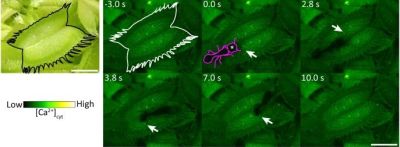Carnivorous plants are a fascinating part of the natural world, especially species like the Venus flytrap (Dionaea muscipula) that rely on what is effectively a spring-loaded trap to ensnare unsuspecting prey. As also seen with species like the waterwheel plant (Aldrovanda vesiculosa), species like sundews are a lot more chill with movement in the order of seconds, excluding D. glanduligera which displays a similar sub-second response as the Venus flytrap. Over the years there has been much speculation about the exact mechanism that enables such a fast response, with [Hiraku Suda] and colleagues offering an explanation, via a recently published paper in Nature Communications.

The sensory hairs that line the Venus flytrap’s leaves are finely tuned to respond to certain kind of stimuli using calcium threshold signals. This is something which was previously known already, but the exact mechanism still proved to be elusive.
This new study shows that a mechanosensor called DmMSL10 lies at the core of the touchiness of these plants by breeding a version where this particular stretch-activated chloride ion (Cl–) channel is absent.
While the mechanical action of the sensor hair triggers the release of calcium ions in both the wild- and knockout dmmsl10 variant, the action potential generation rate was much lower in the latter, while the former continued to generate action potentials even after major stimulation had ceased. This demonstrates that DmMSL10 is essential for the processing of slight stimulation of the sensor hairs and thus prey detection.
A subsequent experiment with some ants being allowed to wander around on the leaves of the wild- and knockout type plants further served to demonstrate the point, with the wild type catching the first ant to waddle onto the leaf, while the knockout type leaf didn’t even twitch as four successive ants failed to propagate the calcium signal sufficiently to close the leaf.
With this knowledge we now have a likely mechanism for how D. muscipula and friends are able to generate the long range calcium signals that ultimately allow them to snack on these tasty protein-and-nitrogen packets on legs. Further research is likely to illuminate how exactly these mechanisms were evolved in parallel with similar mechanisms in animals.

















